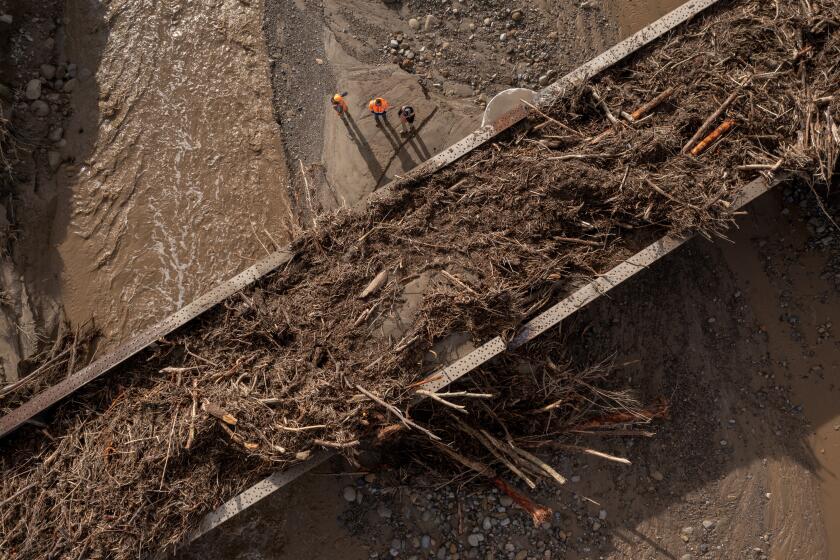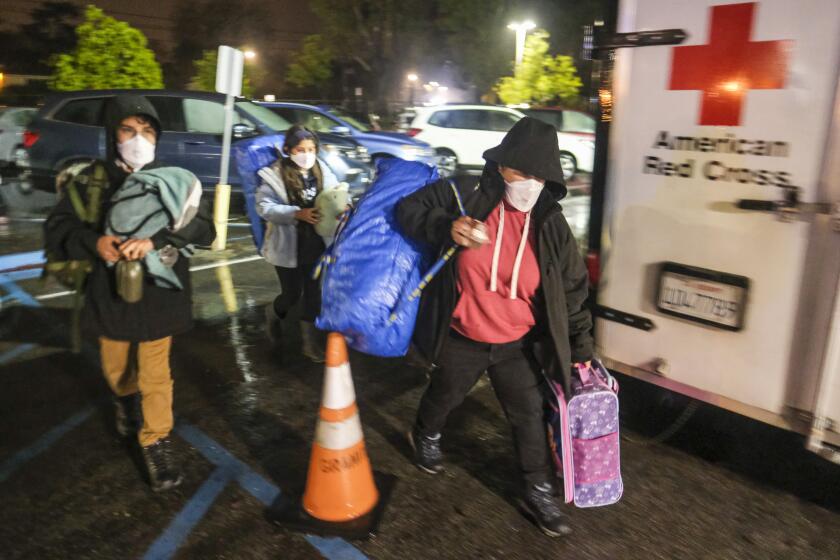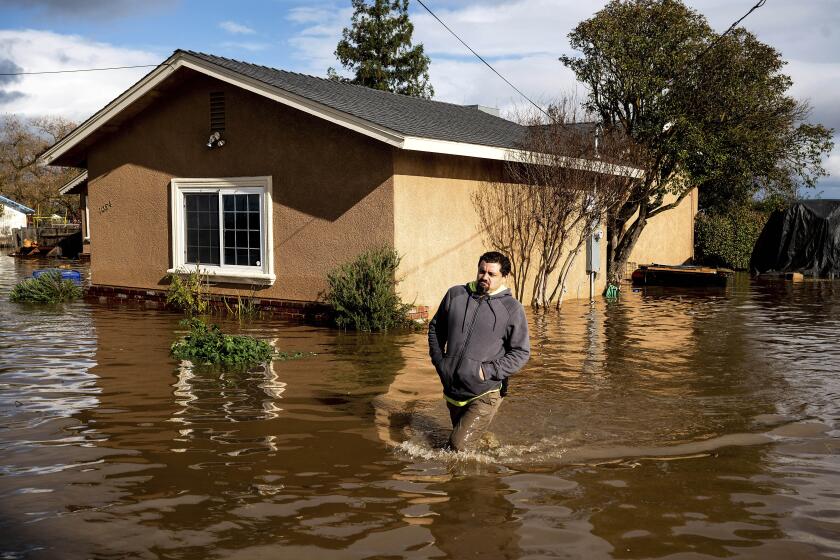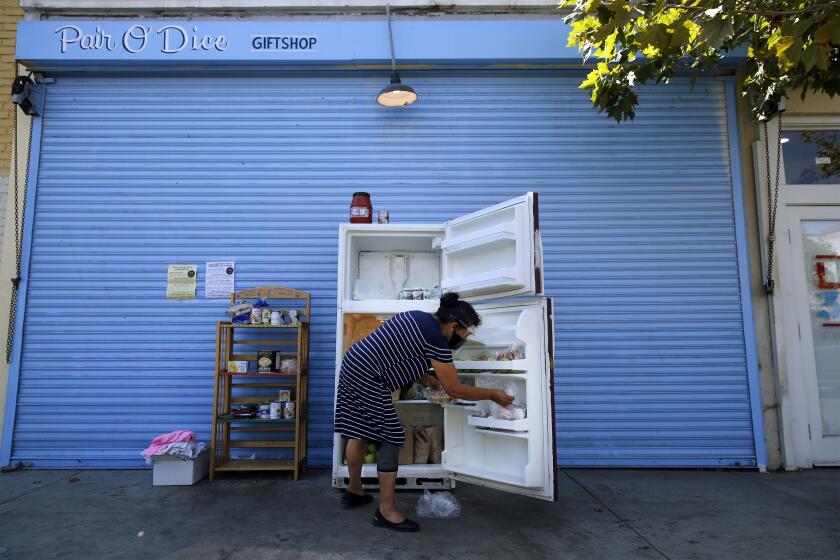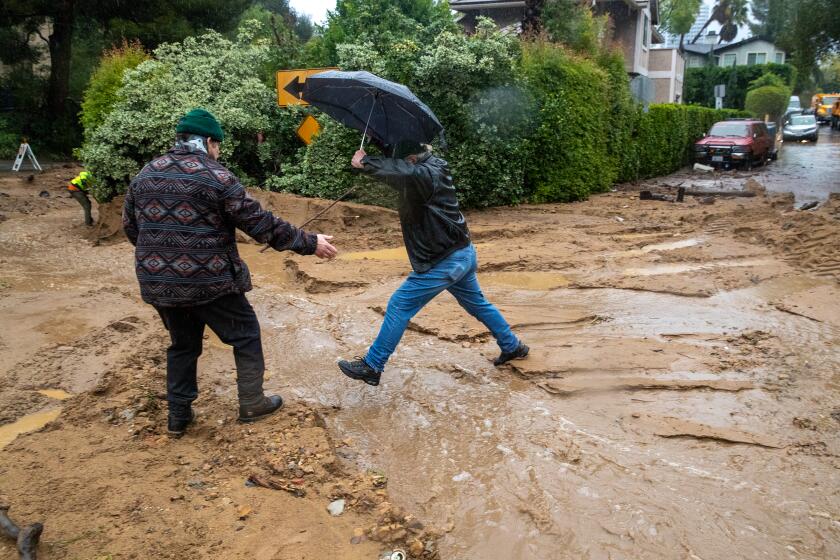Death toll rises to 19 in California as new storms hit battered communities
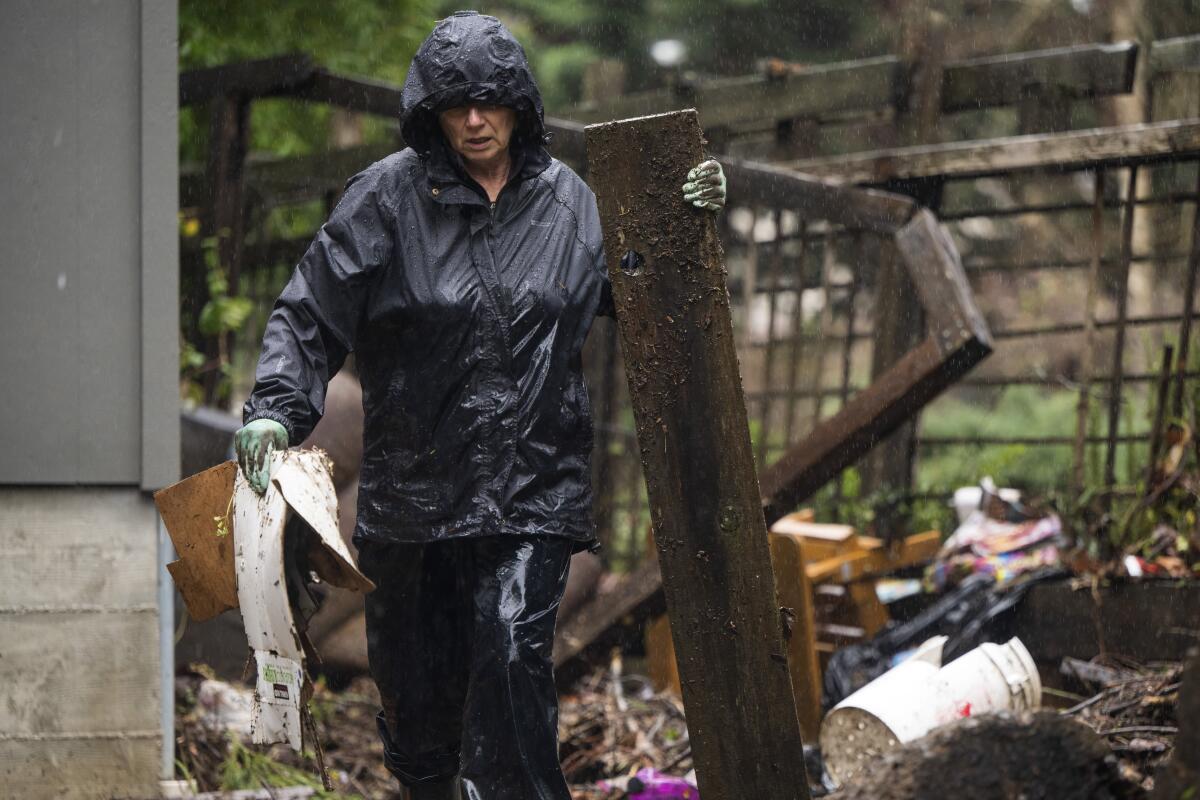
- Share via
SACRAMENTO — From the Pacific coast to the Central Valley, California communities battered by days of destructive flooding began repair and cleanup efforts Wednesday as the weather-weary state found itself in the path of yet another in a parade of storms.
The latest system — the seventh atmospheric river storm to train its eye on the state since Christmas — further swamped a state already reeling from widespread flooding, mudslides, washed-out roads, and downed trees and power lines.
“I guess it’s about time we had this kind of notoriety,” said Alan Vidunas, as he walked in the devastated seaside town of Capitola with his 10-year-old dog, Seabass. “I always call my friends in Florida after they’ve been hit by hurricanes. They’re now calling me.”
The powerful storm that knocked out power, toppled trees — including one that killed a toddler — and flooded homes along the coast in Santa Cruz continued its march through the region.
Capitola, in Santa Cruz County, is but one of many California communities trying to get its arms around the damage wrought by recent storms — which showered sheets of rain across the state, causing roadways to flood, hillsides to crumble, and rivers and creeks to crest their banks. A tornado also briefly touched down in Calaveras County on Tuesday morning, causing extensive tree damage, according to the National Weather Service.
The death toll from the sudden and powerful storms rose Wednesday after Sonoma County sheriff’s officials announced a person had been found dead in a car submerged in 8 to 10 feet of water. The El Dorado County Sheriff’s Office also confirmed Wednesday that a 33-year-old man was found dead in the American River on Jan. 3, bringing the total of confirmed storm-related fatalities to 19.
And a 5-year-old boy who was swept away by floodwaters in San Luis Obispo County on Monday was still missing Wednesday night as more than 100 members of the California National Guard joined the search effort.
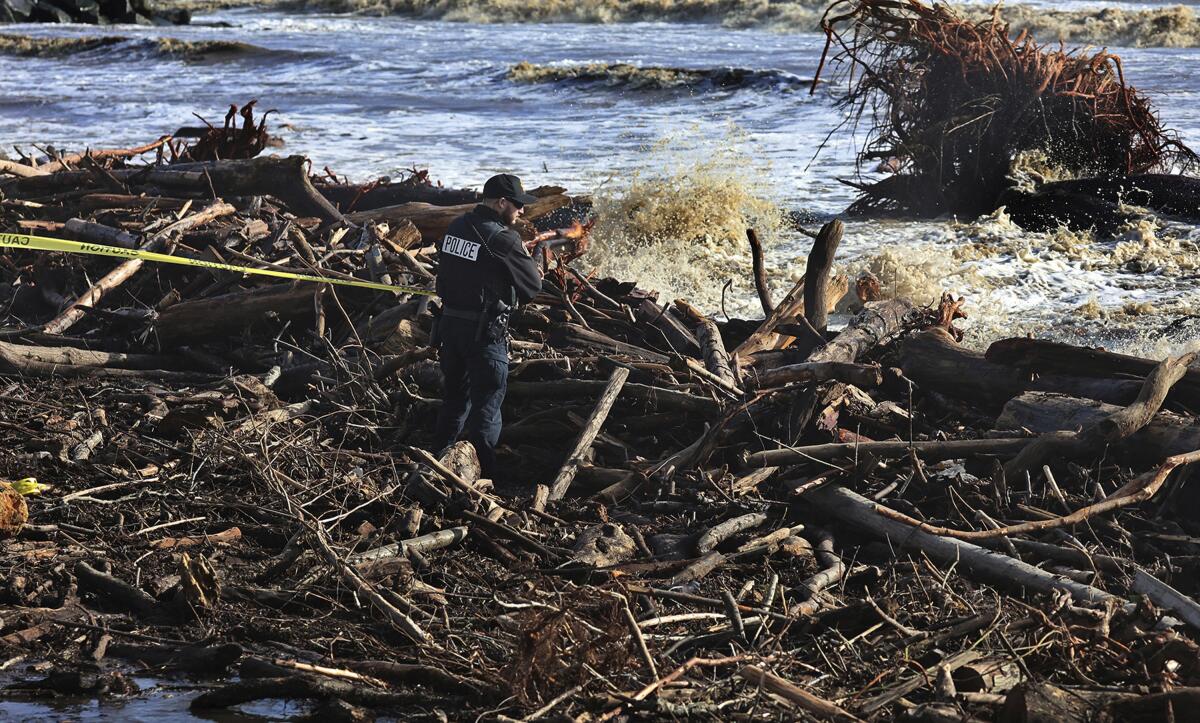
While officials in many parts of the state were turning toward recovery and repair Wednesday, others were still in crisis as swollen rivers spilled over.
Late Wednesday night, almost all areas along the Salinas River in Monterey County were under evacuation orders or warnings, as were parts of the Carmel Valley.
The Salinas River at the town of Spreckels could enter flood stage as soon as Thursday afternoon and peak Friday night, with the potential for the second-highest flood level on record, said Jeremy Arrich, manager of the Division of Flood Management with the California Department of Water Resources.
Flooding on the river could close Highways 1 and 68 as well as Blanco Road, which would sever access between Salinas, the county’s most populous city, and the Monterey Peninsula.
“Residents both on the peninsula and in the Salinas area should expect to be cut off for two to three days,” Monterey County officials said in a statement.
Sheriff Tina Nieto urged residents and businesses to prepare “for what could be the ‘Monterey Peninsula Island,’ as we call it,” she said at a news conference. “Monterey Peninsula may become an island again like it did in the ’95 floods.”
Widespread flooding also forced the evacuation of the community of Planada, a town of about 4,000 people just east of Merced. Though water levels have started to recede, the Merced County Sheriff’s Office said Wednesday morning that it was “unsafe to go back into flooded areas” and the evacuation order was still in place.
County Supervisor Rodrigo Espinosa said more than half the town, which is home to many farmworkers, flooded. Officials were hoping to marshal government and nonprofit resources to get aid to people, he added, and were also working furiously to shore up the sewage plant in Planada so it doesn’t send raw sewage into the already decimated community.
“It’s very sad,” he said. “We’re just trying to get help to residents.”
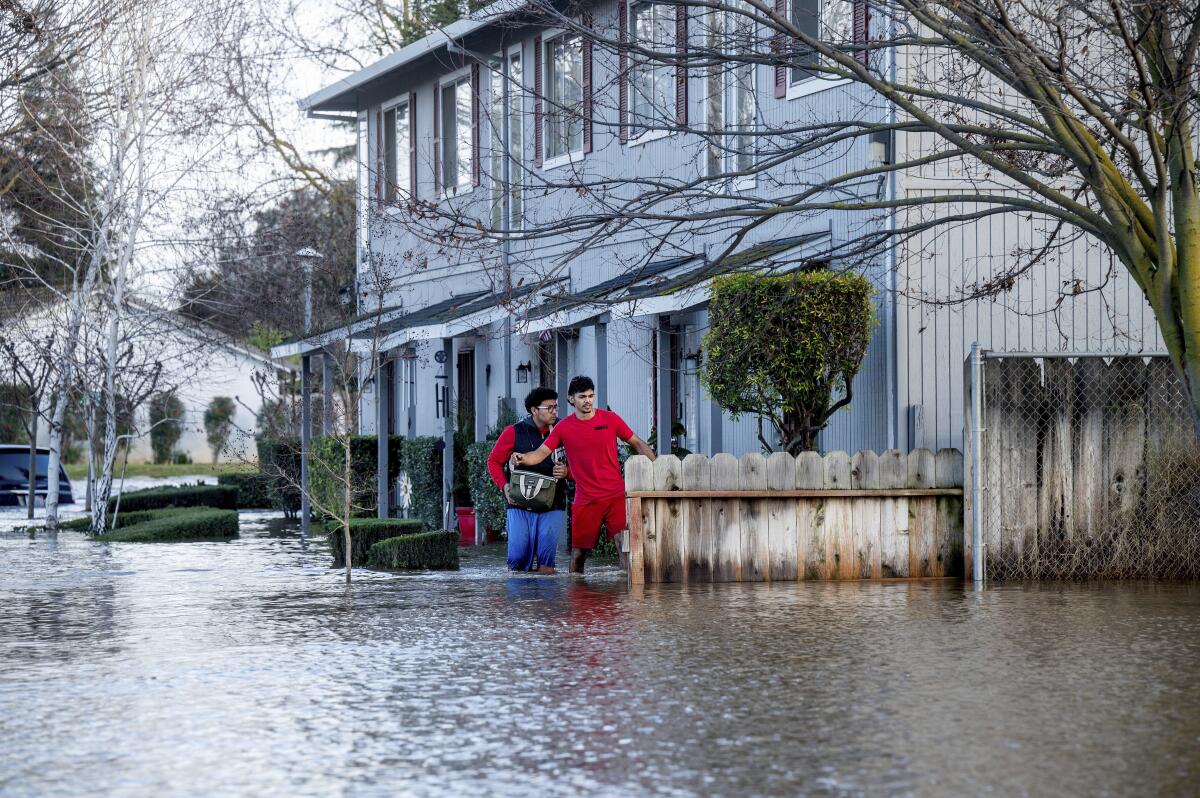
Planada resident Juana Garcia, 38, has been staying at a Holiday Inn in Chowchilla ever since she and her family were forced to evacuate on Tuesday.
The storm flooded Garcia’s backyard and broke her fence and doghouse. Because her home is slightly more elevated than others nearby, the inside didn’t get wet. But when she left for her mother’s house around 2 a.m. Tuesday, the water in the driveway was knee-deep.
“I’ve never experienced something like this,” she said. “We just bought this home a month ago and they told us it’s required to get flood insurance because we’re in a flood zone area. That’s the first I ever heard about it.”
At least 100 Planada households that weren’t in the evacuation area chose to stay and ride out the storm, according to Alicia Rodriguez, an active member of the community.
In an age of extreme weather whiplash, deadly storms are testing the state’s flood infrastructure and its emergency response systems.
Those who stayed behind have been living without electricity for more than 24 hours, she added.
“They’re helpless, scared and concerned for their families and how to feed them,” she said. “They don’t have any hope.”
About 33,000 Pacific Gas & Electric Co. customers in Northern and Central California remained without power because of storm-related outages Wednesday evening. The utility has called this “the single largest winter storm response” in its history.
“The weather looks favorable for restoration over the next few days, although issues with flooding and access remain in some locations,” officials said.
The seventh atmospheric river storm since Christmas was expected to hit California on Wednesday, and more flooding is possible through the weekend.
Recovery efforts are underway under the looming threat of even more storms, which could further douse some already inundated areas through the weekend.
Over the last 16 days, “large portions of Central California received over half their annual normal precipitation,” according to the National Weather Service. That was true in Oakland at 69%; Santa Barbara, 64%; Stockton, 60%; downtown San Francisco, 59%; and downtown Sacramento, 50%.
Santa Cruz County Supervisor Zach Friend characterized recent storms as “a once-in-a-generational challenging event” that has affected the whole county.
“We know this is going to be a long rebuild. We know we’re going to need a lot of resources,” he said during a news conference Tuesday. “But what we also need is a sense of resilience from all of us to be able to rebuild this area — because we’ve seen the tears, we’ve seen the anger, but we’re moving into a resilience phase where we’re just trying to rebuild, bring that hope back.”
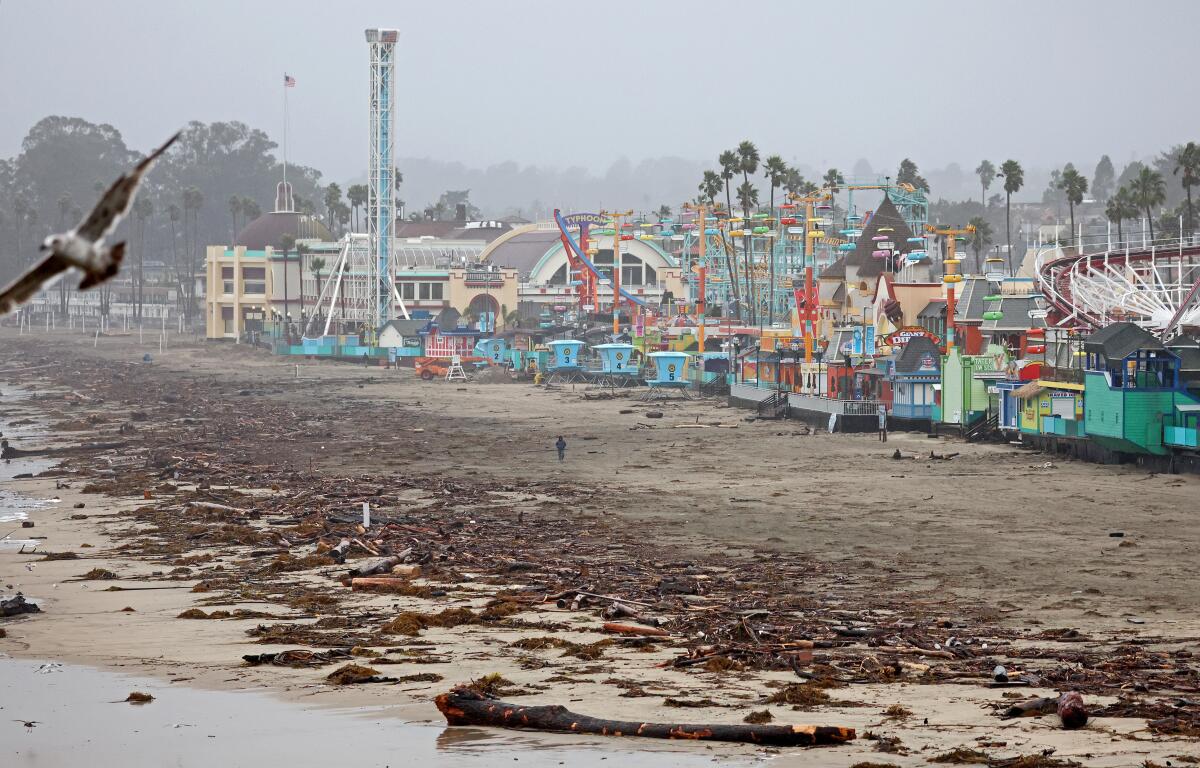
Michael Anderson, state climatologist with the California Department of Water Resources, said the forecast indicates a reprieve after Jan. 20.
“High pressure will build in, and we’ll see a little chance to recover from these series of storms,” he said.
But with so much water already in the system, many rivers will continue to run high even after the rain ends.
“That’s something to pay attention to is the hydrologic conditions will continue to evolve, particularly in our larger rivers, even as the storms abate,” he said.
When the power goes out, the clock starts ticking on the food in your fridge and freezer. But you shouldn’t cry over spoiled milk. See if you can be reimbursed instead.
Although it’s too early to estimate, the cost to repair the damage from these storms could exceed $1 billion, said Adam Smith, an applied climatologist and disaster expert with the National Oceanic and Atmospheric Administration. California’s storms would be the first billion-dollar disaster of 2023.
“We’re here for the long haul, not just here for this moment,” Gov. Gavin Newsom said during a news conference Tuesday.
Arrich, manager of the Division of Flood Management, said five river locations in the state are forecast to exceed the flood stage in the coming days, including the Salinas River at Spreckels. There are 23 river sites forecast to reach the monitor stage, though the numbers could change as conditions develop.
Bear Creek in Merced County has had “quite a bit of activity” in recent days, he said. Specialists on the ground are working closely with the county to respond to incidents in the area, including placing about 100,000 sandbags and 576 linear feet of portable barriers known as muscle wall.
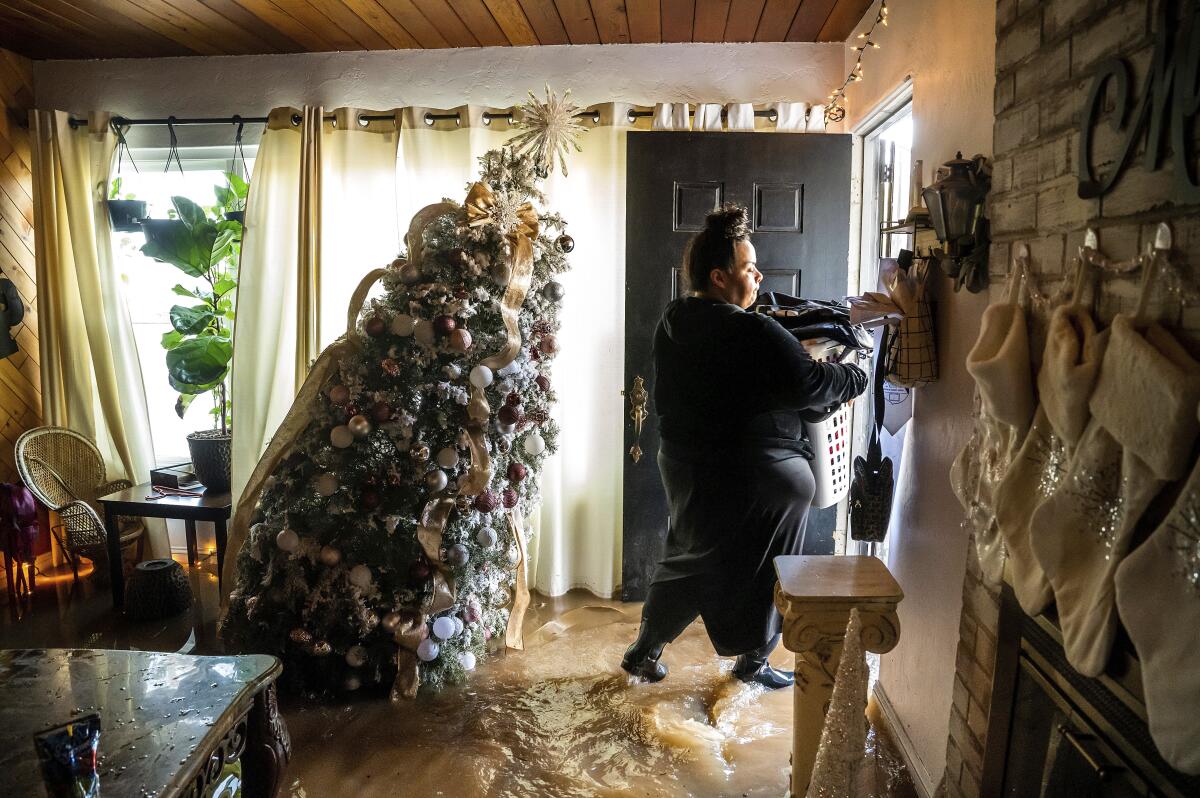
The community of Planada has been affected by Miles Creek, “which essentially overtopped into a drainage canal and then caused flooding in that community,” Arrich said. Crews are responding to multiple levee breaks along the creek, mostly downstream of Merced, he said.
“There’s a number of things going on with respect to that levee,” he said. “As these things go, it’s a pretty dynamic situation out there.”
As of Wednesday, four of the six weirs in the Sacramento River flood control system are flowing, including Moulton, Colusa, Fremont and Tisdale, he said. Officials do not anticipate opening the Sacramento weir.
A flood warning remains in effect through Thursday morning across parts of Mariposa and Merced counties, according to the National Weather Service. Flood watches or advisories were in effect Wednesday for a wide swath of Northern California.
Astonishing rainfall in L.A. County caused mudslides, flooding and a massive sinkhole.
Winds won’t be as strong as those from earlier this week, but still, downed trees are possible and the coast and mountains could still see gusts of up to 60 mph.
The hard-hit Santa Cruz Mountains and the North San Francisco Bay could see rainfall of up to 3 inches through Wednesday night, with less rain likely for the East Bay, Monterey Bay and Central Coast. Wind gusts of up to 60 mph are also possible.
Chances of rain persist through Thursday.
It remains unclear whether Thursday will give a reprieve to the soggy North Bay, which “would be a bad scenario,” the weather service said. The Russian River at Guerneville in Sonoma County narrowly avoided surging into flood stage in recent days but could still exceed it briefly on Thursday before receding and again on Sunday.
A NOAA expert thinks the costs of the atmospheric river hitting California could top $1 billion.
The next storm is set to hit Northern California on Friday into Saturday, and a thunderstorm or two is possible.
Another could strike on Sunday and persist through Martin Luther King Jr. Day into Tuesday.
Anderson said the expected eighth atmospheric river storm will probably have broad statewide reach, with precipitation expected “from the Oregon border all the way down to San Diego.” The heaviest accumulations will be in mountainous areas along the coast as well as in the Sierra Nevada.
The subsequent ninth storm looks to be more focused on the Northern Sierra, or north of the Golden Gate region, he said, though it’s far out enough that the forecast could change.
The powerful storm that knocked out power, toppled trees — including one that killed a toddler — and flooded homes along the coast in Santa Cruz continued its march through the region.
With about 1 to 3 inches of rain expected, Anderson said the incoming atmospheric river isn’t quite as strong as the earlier storms.
But “the challenge is they’re storms eight and nine in the sequence, where the cumulative effect is likely to cause impacts larger than the storms themselves might.”
Times staff writers Hayley Smith, Susanne Rust and James Queally contributed to this report.
More to Read
Sign up for Essential California
The most important California stories and recommendations in your inbox every morning.
You may occasionally receive promotional content from the Los Angeles Times.
